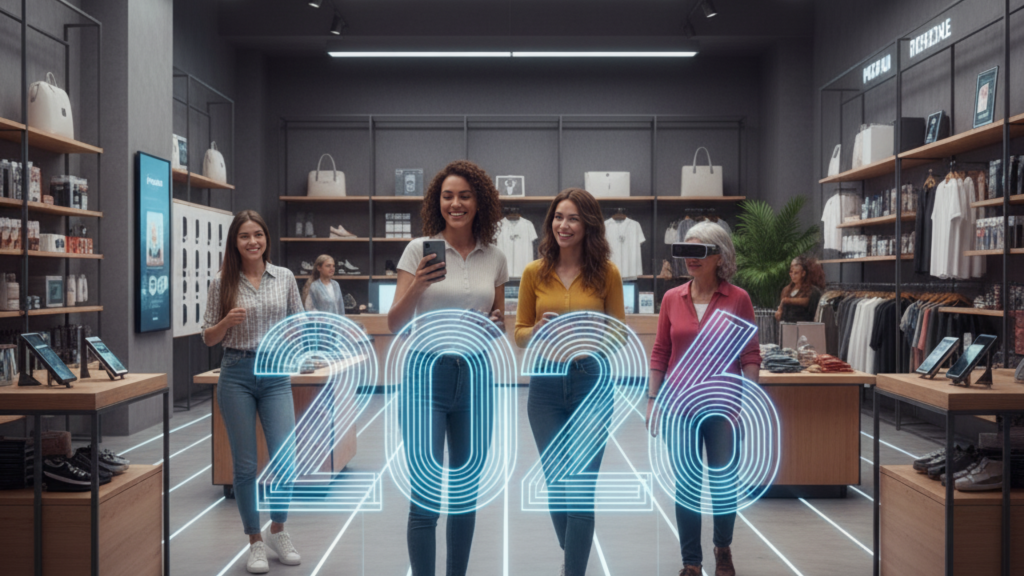
The retail landscape is evolving at breakneck speed. These are the trends that will define 2026 and how you can prepare to capitalize on them.
After years of prioritizing growth, retailers now face a more complex equation: profitability over expansion. Analyzing 2026 retail trends is crucial for developing an effective strategy. The projection is clear: global retail is set to grow by approximately 6% that year, adding $800 billion in sales.
1. Retail Media Networks: The New Advertising Giant
Retail Media Networks are growing at a rate of 14% annually, becoming the third wave of digital advertising, following search and social media.
These are retailers’ proprietary advertising platforms where brands pay for targeted ads displayed within physical stores, websites, and mobile apps.
Their competitive advantage is clear. While Google and Meta sell search intent, Retail Media Networks sell actual purchase intent backed by precise transaction data.
2. Artificial Intelligence and Extreme Personalization
AI is once again positioning itself as a key pillar of retail planning for 2026. Its role is critical for meeting what has become a baseline expectation: hyper-personalization.
But the focus is shifting. It is no longer enough to personalize marketing; AI must personalize operations. This means using it to anticipate local demand and ensure the exact product is on the shelf when the customer looks for it. This level of execution is the new standard for loyalty, as advanced AI-driven personalization has been proven to increase conversion rates significantly.
3. Omnichannel and the Transformation of the Physical Store
Today, 73% of consumers use multiple channels to shop. And while 80% of transactions still occur in physical stores, digital-physical integration is mandatory. Your stores must evolve.
They are no longer just transaction points. They are transforming into experience hubs: interactive showrooms, express pickup locations, and community spaces that strengthen the brand connection.
4. The Impact of Generation Z and Sustainability
Generation Z comprises one-third of the global population, with projected purchasing power expected to reach $12 trillion by 2030.
This group demands sustainability. 73% report that they would change their consumption habits to reduce environmental impact. When they view a brand as environmentally conscious, they are more likely to buy its products compared to older generations.
They are driving the circular economy. 8 out of 10 Gen Zers buy secondhand. Brands are taking notice: retailer-operated resale platforms have seen a 325% growth since 2021.
5. The Next Frontier: Voice Commerce and Livestream Shopping
Two emerging formats are growing strongly and complete the 2026 retail trends landscape:
- Voice Commerce enables consumers to search for and purchase products using voice commands through virtual assistants like Alexa, Google Assistant, or Siri. The market is growing at a 3% rate, with nearly half of US consumers already using it for their purchases.
- Livestream Shopping combines entertainment and commerce, featuring live broadcasts where influencers or salespeople present products, allowing viewers to make purchases directly. This format resonates with all ages, from Gen Z on TikTok to Boomers on Facebook.
Executing Your Strategic Vision
These 2026 retail trends are realities already impacting the industry.
The challenge for retail teams is translating these trends into concrete strategies. Your company is likely already discussing how to approach AI for personalization, addressing sustainability demands, or whether to invest in Retail Media Networks.
However, there is a critical point that defines success: none of these grand strategies can succeed without flawless operational execution in the store.
What good is your AI sending a perfect personalized offer for a sustainable product to a Gen Z customer if, when they use the omnichannel in-store pickup option, your team can’t find the order, and the experience fails?
The challenge is closing the gap between the plan and the reality at the store. At Frogmi, we understand that perfect execution is the foundation upon which all these trends are built. Our platform supports precisely that: the correct implementation and execution of your strategies, ensuring that headquarters and your retail locations communicate within a unified ecosystem.
2026 is almost here. The question isn’t if these 2026 retail trends will affect you, but how prepared your operation is to execute them.

